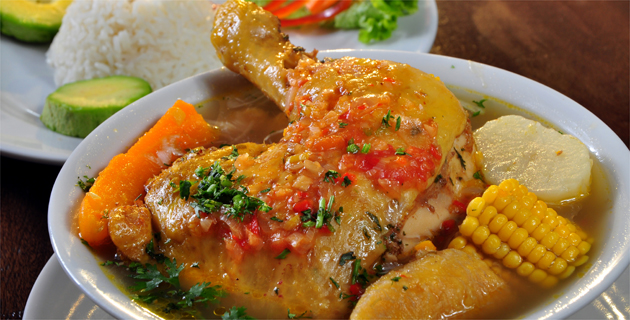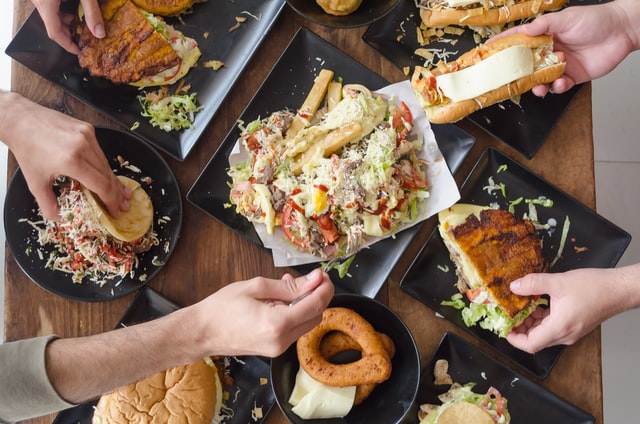If you haven’t tried Colombian food, you’re missing out on flavors that cover an array of regions and natural ingredients. With influences from Spain, Africa, and indigenous groups throughout Central and South America to name a few, Colombian cuisine is rich in culture, style, and history.
The mainstays of Colombian food are grilled meats, soups, and stews that are steeped in local ingredients, earthly flavors, and hearty portions. Because of Colombia’s biodiversity, each region features unique dishes and a large variety of traditional recipes. Colombia also grows an abundance of tropical fruits, such as passionfruit, mangosteen, feijoa, and guanábana, and the country has also cultivated other sweet treats like churros rellenos and dulce de leche! There is no lack of incredible food in this gastronomic wonderland.
If you’re traveling to Colombia, these are the top eight dishes you must try to truly immerse yourself in Colombian culture.
Arepas
Arepas are the backbone of Colombian food and the oldest known food recipe in the country. They are circular patties made out of maize (corn flour) that can be fried, roasted, or grilled to perfection. Arepas are typically eaten in two ways: as a side to a hearty dish or filled with goodies and eaten on their own. Many market carts and casual restaurants will stuff them with cheeses, meats, and veggies. As a result, arepas can be a hearty snack or a fulfilling meal.
The history of arepas dates back to the pre-Colombian era. Various indigenous groups harvested maize and made many types of dishes that included this corn cake treat. Today, there are 40 known types of arepas still being made throughout Colombia, Venezuela, Panama, and Bolivia!
Arepas predate the Spanish conquest, making this food item an integral part of Colombia’s heritage and culture. However, they’ve been transformed over the years into a popular street food item. From market stalls to gastronomic delights in high-end restaurants, this Colombian staple is a must-try!
Bandeja paisa
Bandeja paisa, also known as bandeja montañera, is a traditional Colombian breakfast dish created by the Paisa people who live in the Antioquia region of Colombia. However, there are several variations, as it can also be found throughout many other Central and South American locations.
In Colombia, the dish consists of red beans, white rice, chorizo, plantain, hogao sauce, ground meat, chicharrón, black pudding, avocado, arepa, and a fried egg. With its hearty portions, bandeja paisa was originally eaten by peasants as a way to prepare for a day of hard work in the fields.
In 2005, the Colombian government named bandeja paisa the country’s national dish. It’s now served in high-end restaurants to showcase the pride of Colombia’s history and culture. However, it can also be found in local mom-and-pop shops throughout the country. Get your stomachs ready for this Colombian sampler!
Tamales
Tamales are a traditional food item throughout Mexico, Central and South America. What was once a holiday or celebratory food is now an international superstar. They can be found in the U.S. and even Europe. Many feel this ancient food dates back thousands of years, which reveals its significance in Colombia’s history. It’s believed that Mesoamerican tribes created tamales because they were easy to transport and provided lasting sustenance on long treks.
While tamales are made in various ways, the basic ingredients are masa dough wrapped in either banana or corn leaves. In Colombia specifically, tamales are traditionally less spicy than in other areas where they are eaten. They are always wrapped in plantain or banana leaves and many fill the leaves with meats, cheeses, chilies, vegetables, and fruits. On your next trip, try an array of tamales and see which style you like best!
Lechona
The word lechona translates to “suckling pig” and is said to have its origin in the region of Tolima. Traditionally, lechona is served at large events, holidays, and parties, as it consists of roasting an entire pig. While many cultures feature pig, this authentic meal isn’t cooked in the same way as a roast pig on a spit. Lechona is typically baked in a clay or brick oven and takes about 10 hours to cook.
To create this traditional Colombian dish, the pig is cut and prepped. Next, the pig is stuffed with rice, peas, pork fat, and onions with other variations depending on the region. Lastly, it’s covered in orange juice as a sweet and sour marinade before heading into the oven.
Most serve the dish with arepas and sauces. Adding side salads and other goodies like fruit is quite common, too. Depending on the pig’s size, this Colombian dish can serve 100 people! You can find this traditional meal at many local restaurants, giving you a chance to try a small portion of Colombia’s history.
Mondongo soup
Mondongo is a tomato-based soup that features beef tripe (cow stomach) and pig or calf feet. Many feel this dish became popular in Colombia around the 17th century during the time of Spanish colonization. However, natives connect its roots to Africa, as many slaves cooked and ate this dish because it was quite cheap to make.
Mondongo is a staple in Colombia, the Dominican Republic, and Puerto Rico. Most families have their own recipe, but the majority of the ingredients remain the same throughout. Not many outside of Latin America know about or make this soup due to its unique proteins.
While tripe and pig/calf feet are the major players in this dish, spices, herbs, and vegetables are added for flavor and texture. You can find this traditional soup throughout Colombia — it’s a must-try for an authentic foodie experience.
Ajiaco soup
Ajiaco is a popular soup that typically consists of chicken, multiple types of potatoes, corn on the cob, and guascas (a dehydrated herb). This comfort food can be served as is but some like to add rice or avocado into the literal mix. While the dish is a staple in Colombia, it can be found throughout Latin America with historic roots in Cuba and Peru. However, there is contention over where this dish originated. Some feel the name comes from the indigenous tribe of Taino, as Aji means “hot pepper” in the Taino language. Others feel this soup has been a staple in places like Peru and Colombia for centuries, since both countries are known for growing various types of potatoes.
What we do know is that the dish was served in Cuba as far back as the 16th century and holds a significant place in Colombia’s history. In Colombia, you can find this delicious soup on the streets, in the food stalls, and in local restaurants throughout Bogotá. If you’re coming to town, this soup is a must!
Perro caliente
Perro caliente literally translates to “hot dog,” but this Colombian specialty is like no other hot dog you’ll ever try. Topped with items such as bacon, mayo, pineapple sauce, potato chips, mustard, quail eggs, pink sauce, and so much more, this Colombian dish will fill your heart, soul, and stomach!
Many chefs steam or boil the dogs in a combo of Coca-Cola and water, drop them on a steamed bun and add the toppings that speak to their culinary tastes. This Colombian street food favorite may look overwhelming, but it’s a hands-down must-try. Whether you need a quick lunch in between excursions or you need a late-night snack after the bars close, ordering a perro caliente is the ideal choice.
Sancocho

Sancocho is another traditional soup that is a must-try when traveling to Colombia. Essentially, this favorite is the Colombian version of chicken soup. While sancocho is a staple in various regions in the country, it has numerous variations throughout Latin America.
The base of this thick soup is made from several root vegetables and meats that range from chicken to oxtail. It contains a hearty portion of protein and is generally topped with herbs, peppers, garlic, and scallions. Depending on the region and the cook, you’ll find other toppers, such as potatoes and corn. In Colombia, this dish is served with avocado, white rice, and hot sauce on the side.
You can find this delicious dish throughout the country at local mom-and-pop shops, casual restaurants, and markets. Don’t leave Colombia without trying this local favorite!
About TourHero
TourHero is a social travel platform that enables you to travel with like-minded people and fall in love with the journey. We work closely with handpicked local operators to ensure every experience curated is unique and exclusive to your travel group. Come with us on epic adventures and create memories that last a lifetime. Get started here!










